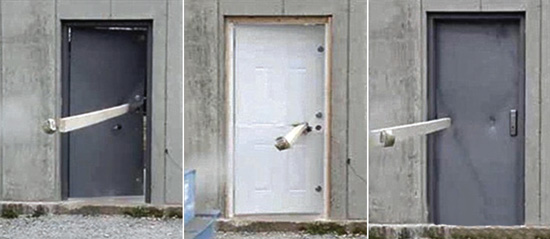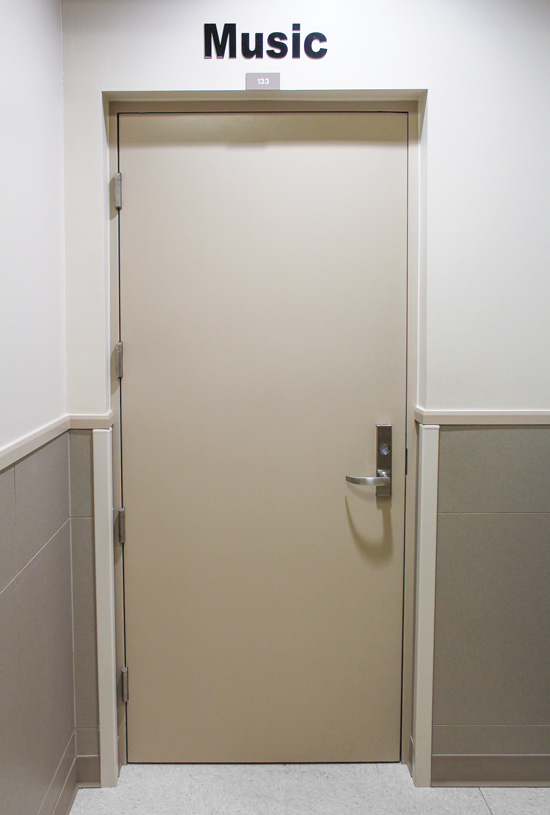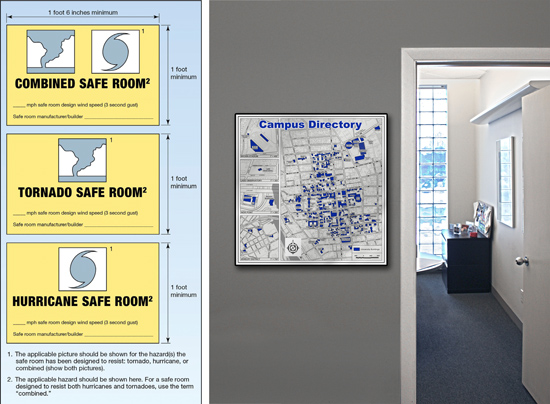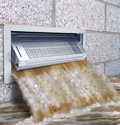Designing for Extreme Environments
Tornadoes and Hurricanes
Residential and commercial buildings that incorporate safe rooms or shelters following ICC-500 or FEMA guidelines are becoming more popular, particularly among increasing urban populations seeking protection from violent tornadoes or hurricanes. The engineered construction of the walls, roof, and floor are fairly straightforward in terms of using substantial, reinforced materials (i.e. concrete, CMU, etc.) following the standards. However, the room or building will only be as strong as its weakest part, which in some cases has proven to be the door leading into it. Just as the walls and roof of a safe room are designed and built to protect against extreme winds and wind-borne debris, so too, the whole door assembly (door, frame, and hardware) must be designed together to do the same. When careful selection and installation of the safe room door assembly is not part of the overall design, then the safe room door opening can leave occupants at great risk of injury or even death during high-wind events.
Contrary to some perceptions, ordinary steel doors used in residential and commercial construction are not appropriate for safe rooms. There is a common misconception that a steel door marketed for storm protection with three locks and three hinges can provide the needed protection in tornadoes, but testing has demonstrated that they cannot. While they might remain in place and closed in some high-wind conditions, they cannot withstand the impact of the wind-borne debris, or “missiles,” that a tornado can propel. Dramatic failures have occurred when such wind-borne debris (wood studs, metal posts, sign supports, etc.) have struck steel doors. In some cases, the missile-like projectile can hit the door, penetrate all the way through, and either harm people inside or allow high winds to enter. In other cases, the hardware can be damaged and fail, allowing the door to swing open and/or shut in the wind and bringing the unwanted weather inside the safe room.

Photos courtesy of FEMA Federal Insurance and Mitigation Administration Fact Sheet, September 2014
Impact test results on safe room doors show failure at the latch/lock (left), failure by full penetration (center), and a passing condition that withstood both penetration and latch/lock failure (right).
FEMA points out that only door assemblies designed and tested to resist tornadoes can provide the needed life-safety protection for a safe room or shelter. In this case, the door assembly includes the door, hardware (locks and hinges), frame, and attachment devices used to anchor the door frame to the surrounding safe room wall. When selecting and specifying such assemblies, architects need to be sure that components have been tested together specifically for a tornado safe room. FEMA is not the entity that tests and certifies products, rather, the manufacturers of safe room door assemblies must obtain independent certification. The commonly accepted practice is through labeling by third parties, such as Underwriters Laboratories (UL), Intertek Testing Services (ITS), or others. Such labels specified for occupant protection should be issued by the agency that approved them to show basic information, including the name of the manufacturer plus performance characteristics, such as the test missile size and speed or test pressure.
Recognizing this testing and labeling, specifications can request documentation certifying that the door assembly is compliant with the most current versions of FEMA’s safe room publications (FEMA P-361 and FEMA P-320) or ICC-500 for a tornado wind speed of 250 mph. The entire safe room door assembly must have passed the required testing exactly as it is to be installed in the safe room to make sure it will withstand the required tornado wind pressures and debris impacts. This includes the door frame, the anchoring method, the door itself, and the hardware. Note that some suppliers may offer the door and frame without the tested hardware; if substitutions are made, the door may fail during a tornado. Installation instructions, whether in the specifications or from a manufacturer, should be specific to the actual safe room wall type of the building (e.g. wood frame, concrete masonry units (CMUs), etc.).
The significance of this total testing and certification cannot be overstated since there are plenty of non-tested “storm door” assemblies on the market promoted for use in safe rooms that may not perform as intended. In reality, there is no substitute for a tested and certified/labeled tornado safe room door assembly.

Photo courtesy of AMBICO Limited and Securitech Group, Inc.
Tornado safe room doors need to be tested and certified based on the specific assembly of the door panel, the door frame, and the hardware used, even when used in rooms that double for other uses.
Communication
During any extreme weather or emergency condition, effective communication between people is critically important. The FEMA and ICC-500 standards recognize this importance and include requirements for signage for Community Safe Rooms in particular (ICC 500 Sec 504). These requirements include a sign at every entrance to the safe room, indicating “Tornado Safe Room” or “Hurricane Safe Room,” plus the name of the manufacturer or builder of the safe room, its purpose (i.e. the storm type: tornado or hurricane), and the design wind speed. This information lets people know first of all that the room exists, and secondly what it is designed and constructed to withstand. Additionally, ICC-500 goes on to require an identifying sign, different from the entrance sign, depicting the general location of the safe room(s) and access ways. Such identifying signs should be posted in prominent locations 60 inches above the finished floor to the centerline of the sign. An identifying sign is required adjacent to access doors on the inside of the safe room, in the office of the facility manager, if present, and in the designated safe room manager’s area within the safe room, if present.
Where community safe rooms are located, the community should alert its citizens to their presence and indicate that they are open to the public by installing signs and publishing building manager contact information. The interior or exterior of the community safe room should have a sign that clearly identifies the building as a community safe room, indicating whether it is a tornado, hurricane, or combined community safe room. These information signs need to be placed in clearly visible locations, indoors or outdoors, to alert communities to the presence of the safe room, the intended occupants, the maximum number of occupants, the travel routes to the safe room, the location of the safe room entrance door, and other pertinent details. Depending on the population served, it may be necessary to include signs in languages other than English. Because of the nature of the facilities, all signage used needs to be durable, long lasting, and resistant to things like UV radiation from the sun, temperature, and weather.
During an extreme weather event, it is also imperative that people are able to reach community safe rooms quickly and without chaos. Starting at the larger scale, signs can also identify the area of the community the safe room is intended to serve and can be posted to show the best travel routes to the safe room location. Signs can also inform the residents of the neighborhood served by a safe room about the occupancy limitations during any given event. Wayfinding signage is critical for occupants to be able to readily find and enter the safe room, especially when a safe room is inside a larger building. Signage for safe rooms at schools and places of work should be clearly posted and should direct occupants through the building or from building to building. Main pathways should be marked to direct users to the community safe room. All signage should conform to the requirements of ICC A117.1, Accessible and Usable Buildings and Facilities.
Note that if the safe room is not open to the public, no signage should be placed on the exterior of the building. A safe room sign on the exterior of a non-public safe room is misleading and may result in an undesired response from the public. This unintentional miscommunication may be mitigated through community outreach and carefully placed and specifically worded safe room signage.
Images courtesy of FEMA and Metalphoto® Photosensitive Anodized Aluminum
FEMA and ICC-500 require very specific signage inside and outside of buildings that needs to be durable and clear.
Notice

www.ambico.com and www.securitech.com

details.mpofcinci.com/extreme-environment-signage/

www.smartvent.com









